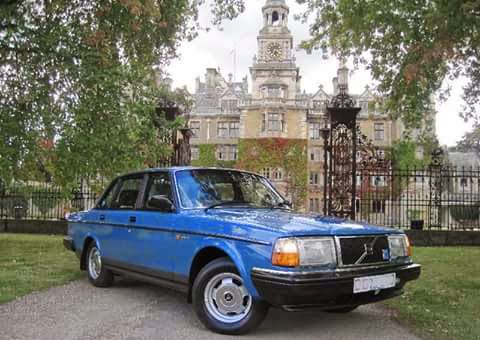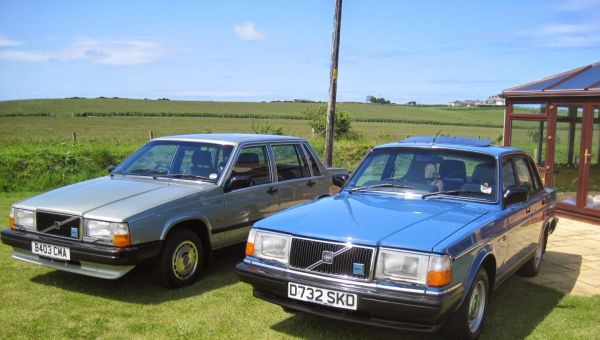Douglas Hughes
Quite frankly, I just loved every single mile spent behind the wheel of those excellent and supremely comfortable cars. I struggled to find anything I actually preferred after production ended in 1998. These awesome cars marked the pinnacle of my motoring career. I covered countless trouble-free miles in the driving seat of these big Volvo cars, creating lots of happy memories along the way.
Automotive Lazarus
The Volvo 740 was introduced way back in 1984, two years after the introduction of the six cylinder 700-Series flagship (the 760). The 4-cylinder 740 was intended as the replacement for the iconic 240 and a more humble (lesser specced) version of the 760. But the 240 was so incredibly popular amidst the Volvo faithful that production continued alongside the 700-Series for a further ten years. The 240 became a sort of automotive Lazarus, going on to miraculously out-live its replacement.
The tough-nut 200-Series had become a quintessential feature of country living, especially in estate guise. They became a sort of automotive wax jacket & green welly outfit; hardly the most stylish get-up in some people's eyes but nevertheless de rigeur amidst the fashionable country set. The 240 actually became a coveted lifestyle accessory which earned its reputation by simply offering practicality, durability, longevity and (of course) unmatched levels of safety.
On the quiet, the 240 was actually a remarkably stylish car. Despite its famed angular styling, the 240 became a bit of a style icon with plenty of built-in street credibility. 240's looked just as much at home in urban settings as they did whilst gracefully crunching their way along the driveways of grand country abodes.
The 240 was indeed the complete package. It did what it did absolutely brilliantly and simply didn't need to do anything much else. This was a truly purposeful vehicle renowned for cavernous load capacities, cosseting comfort as well as being powerful enough to effortlessly tow around a large horsebox. The 240 was therefore as common a sight at the gymkhana as were the actual ponies themselves. This was a car that had found its perfect niche and thereafter fulfilled that role with enviable aplomb.
Cult status
The 200-Series had in fact earned for itself a sort of cult status. They were often regarded as being rather more than a mere family car but more of a trusty, irreplaceable and much loved family member in their own right. A bit like an old butler. The 240's often covered interstellar mileages whilst dutifully and reliably executing their many and varied utilitarian roles without complaint.
The 240's weren't exactly technologically cutting edge but they had no need for any of that jazz. Volvo simply and proudly relied on tried and tested technologies which harked back to a time when Harold Wilson was Prime Minister and Portugal was still subject to the authoritarian rule of the Estado Novo. The 240 was about gradual evolution going back all the way to its earliest incarnations as the 144, first introduced in 1966. The lineage simply encompassed small changes and refinements that were thoughtfully introduced only for the very best reasons. Volvo didn't blindly follow fads or fashions.
Modernisation
When the 740 was eventually introduced in 1984, it was fully 9 years after the idea for a brand new Volvo design had been conceived. The 740 was hailed as a much more modern car despite, in many ways, being quite similar to the 240 under the skin. By saying similar, I mean the 740 featured much the same engines and running gear as those found in the 240's, although all of it had been subject to numerous tweaks and enhancements over a lengthy seven year period of development. Volvo still didn't believe in replacing tried and trusted hardware simply for the sake of it. The Volvo faithful loved this ethos because they knew exactly what they were buying into.
The 740's styling was however definitely striking. I remember seeing one for the first time and being verily taken aback by what I beheld. The 740 saloon seemed huge and had all the hallmarks of a car that had been 'squarely' aimed at the American sedan market. The rear window and the sharp angular C-pillar arrangement looked very 'American' indeed and it epitomised the 'three box' sedan. However, the 740 did look beautifully elegant featuring lots of chrome detailing including expensive looking stainless steel wheel covers. Despite its square edged design, this was a remarkably aerodynamically efficient car when driven at normal speeds.
Volvo cars across the years
The interiors were also beautiful, modern, airy and well thought out. It was a cockpit-like environment with ergonomic wrap-around consoles for lucky drivers to make light work of even the longest journeys. The renowned Volvo-designed seats were finished in beautiful velour trim, pleated and gathered to produce a sense of sumptuous opulence. The 740 may well have encompassed much of Volvo's tried and trusted running gear but it was certainly presented in a very different guise when compared to its predecessors.
The 740 driving experience was also quite different from that of the 240. It had the feel of a modern executive express. It was long-legged, sublimely comfortable and offered a whole new benchmark for ride and handling characteristics.
The 740 continued in its original guise until it was given a subtle restyle (facelift) in 1990. This was definitely a case of 'e-volvo-lution' at play because in late 1992/93 the 740 gently morphed into what became the new 940.
900-Series
The 900-Series was hardly a great departure for the famous Swedish brand because they kept very much the same underpinnings as the outgoing 740 as well as the same interiors, engines and gearboxes. The biggest difference was the 940 saloon's much chunkier and more rounded rear flanks. This was a Volvo with curves featuring impressive new light clusters and a larger, more accessible boot. Gone was the angular rear window in favour of a much prettier sloping design with a more robust looking C-pillar and a bigger parcel shelf. These subtle changes helped the big 9-Series Volvo stride confidently into the 1990s with a fresh new look. The Volvo design team had done just enough to give their flagship a modern appeal without scaring away their band of faithful devotees.
Quite apart from the handsome new styling, ride and handling were also much improved. The 900's borrowed a few of the cutting edge Volvo 850's technological features including SIPS (Side Impact Protection System). The 940's would effortlessly glide along the motorways providing their lucky occupants with new heights of sophistication and luxury combined with the added peace of mind of Volvo's excellent reputation for ultimate reliability, safety and durability.
The end came in 1998 when the curtain finally fell on the last of the RWD angular Volvos of designer Jan Wilsgaard. But my Volvo story didn't end there. Volvos cars were often cherished possessions and it wasn't too difficult to find beautifully kept low mileage examples for many more years to come. And of course - these cars lasted!
Douglas Hughes is a UK-based writer producing general interest articles ranging from travel pieces to classic motoring.






















